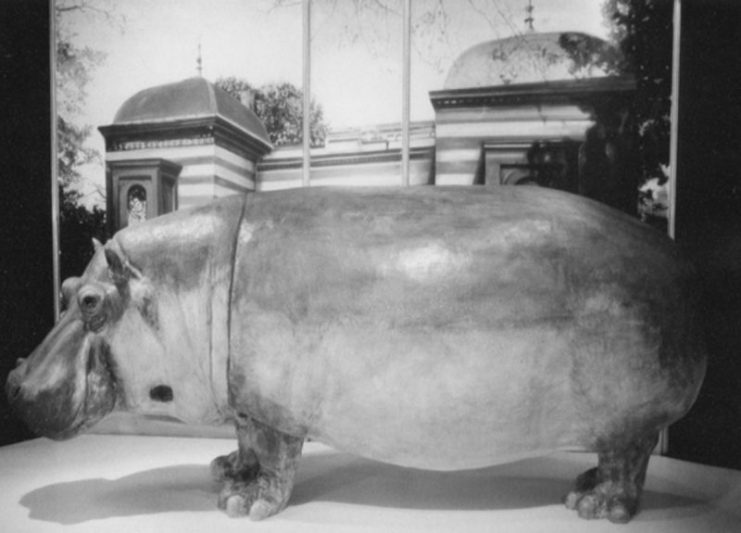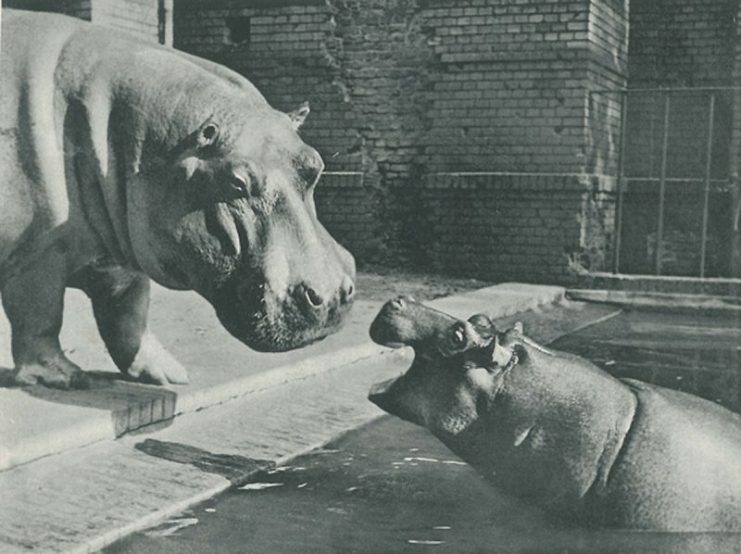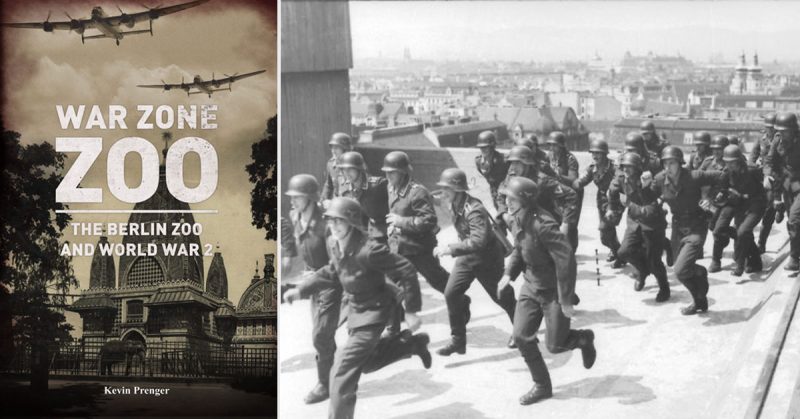May 1945. The war in Europe has come to an end. Bombardments by the Allies and house-to-house combat between the German Wehrmacht and the Russian Red Army have turned the city into a pile of rubble. The impressive 19th century zoo next to Tiergarten Park has also suffered heavily from the violence of war.
Many stray bombs came down on the premises. During the battle of Berlin, the zoo turned into a battlefield as tanks and shells left their destructive traces. The premises of the zoo, once so well-attended, has deteriorated to a gruesome cratered landscape. Dead soldiers and carcasses of animals lie scattered everywhere. Less than 100 of the approximately 3,500 animals have survived.
‘War Zone Zoo’ tells the gripping tale of the Berlin Zoo, its employees and its animals in wartime. Its history and restoration also pass review. This is a story of how violence and dictatorship made the Berlin Zoo lose its innocence, but it is also a story of love for animals, human powers of survival and the rebirth of the historic and public icon the Berlin Zoo still is today.
Below are two chapters of this new book written by Kevin Prenger.
The zoo under fire
On September 8, 1941, the zoo was struck by the first bombs. Six 250 pounders inflicted particularly heavy damage on the forest restaurant and its surroundings while the cattle stables were set on fire by incendiaries. Damage was minimal however and was repaired within a few weeks.
For two years afterwards, the zoo was not hit again with the exception of five 250 pounders which came down on uncultivated terrain between the pastures of the cattle and the wolves. It was on November 22 and 23 the zoo was subjected to the heaviest air raid so far. Arthur “Bomber” Harris, commander-in-chief of R.A.F. Bomber Command had launched the “Battle of Berlin” a few days previously, intended to force Germany to surrender by massive bombing attacks on Berlin and other cities in Germany.
On November 22, 764 bombers of the R.A.F. unleashed a massive attack on the western part of Berlin, including Tiergarten. Over a period of a week, more attacks would follow, claiming 3,758 dead, 10,000 injured and half a million homeless. When it was over, hardly a single habitable house was still standing in the streets around the zoo.
The zoo did not fare any better than its surroundings. On November 22, some time between 19:15 and 19:30, the zoo was hit by various types of bombs, including more than 1,000 incendiary bombs. Raging fires could hardly be extinguished because of the water mains had also been damaged in many places by the bombs. Numerous animal shelters were struck by bombs or burned to the ground, including the shelters of the elephants, monkeys and predators.
Other buildings were damaged as well, such as the quarantine building, various utility buildings and Heck’s villa. In less than 15 minutes, 30% of the zoo population was killed. The next day, towards 20:00 the aquarium building was completely destroyed by a direct hit. In the morning, passers-by on the Budapesterstraße were confronted with the gruesome sight of the lifeless bodies of 4 crocodiles. The reptiles had probably been flung out onto the street by the explosion. If they would have survived the blast, they must have died from the cold outside.

Following the bombardments, frightening rumors erupted in the city about dangerous animals having escaped from the zoo. In the dark shelters just the thought of roaming poisonous snakes and hungry crocodiles was enough to frighten the people to death.
Stories about elephants stampeding through the streets and tigers prowling through the ruins fed the imagination but actually, the Berliners would never have to be afraid of escaping dangerous animals. Apart from the dingo Maria van Maltzan took back to the zoo, only a few monkeys, smaller animals and birds escaped. Josepha von Koskull, employed as a Luftschützwärtin (member of the air raid protection), observed another escaped animal in the morning after the air raid of November 19.
After having weathered ashes and the red hot glare of smoldering heaps of debris on her way to the zoo, she noticed a bewildered looking “shepherd’s dog” near her completely burnt out guard house creeping past. She took pity on the exhausted and dazed animal and wanted to share her slice of bread with it. Just as she was on the point of doing so, two zoo keepers turned up to take the escaped wolf back to its shelter.
During the bombardment, many animals had not even had the chance to escape as they had been killed during the inferno. Of the larger animals, 7 elephants, a black rhino, a chimpanzee, an orang-outan, 7 predators, a couple of giraffes, 2 midget hippos, a sea elephant and half of the antelopes and deer had been killed.
A larger part had survived though: 721 mammals and 1,212 birds of various species. Among the survivors were giraffe Rieke, the female orang-outan Buschi and the gorilla Pongo who had been in the zoo since 1936 and had appeared on the cover of the 1937 issue of the visitor’s guide.
There was only one survivor in the heavily damaged elephant shelter, the bull Siam which had lost its entire harem. As sad as the losses may have been though, they could have been far worse if manager Heck had not evacuated a large number of animals in advance to zoos elsewhere within the Reich.
Prior to the bombardments of November 1943, a number of Heck’s colleagues had declared themselves willing to take in animals for the time being as well as after the raids. In this way animals were temporarily housed in the zoos of Wien-Schönbrunn, Breslau, Frankfurt am Main, Halle, Cologne and Königsberg.
Individuals also had taken animals in and on the Schorf Moor, hoofed cattle enjoyed a habitat undoubtedly well in excess of that in the zoo. A very helpful zoo that took in a large number of animals from Berlin after the November 1943 raids, was the Mulhouse zoo in the Alsace. At that time the city, Mülhausen in German, was part of the German Empire. On February 7 and 10, 1944 transports from Berlin arrived carrying 237 mammals and 149 species of birds, which would have easily filled a fair sized zoo.
Out of the 750 of 247 species, evacuated from Berlin for their safety, only the giraffe Rieke returned from Vienna in 1953. The other animals had either died of old age or by the violence of war, most other zoos in the Reich had been subjected to as well.

While clouds of dust were slowly descending after the November raids, Berliners went about assessing the damage and salvaging the victims; in the zoo, work was taken up quickly to care for the surviving animals and to clear the premises as far as possible.
Forest workers of the Reichsforstamt, soldiers from the Flak tower, a police unit, a platoon of the Technische Nothilfe (emergency rescue team), engineers of the Wehrmacht and prisoners-of-war, they all were deployed to clear up the zoo. A team of veterinarians was brought in to dissect the giant corpses of the elephants so they could be taken to the destruction facility in pieces. In order to take off the edge of hunger after the hard labor, a canteen was established with a very peculiar menu.
“We had meat coming out of our ears. “ Heck declared about this. “Many of the edible animals which had fallen victim to the air raid ended up in the pot. Particularly tasty were the crocodiles’ tails; cooked tender in big containers, they tasted like fat chicken. The dead deer, buffalo and antelopes provided hundreds of meals for man and beast alike. Later on, bear ham and bear sausage were a particular delicacy.” (Source: Moorhouse, R., Berlin at War, Life and Death in Hitler’s Capital 1939-45, The Bodley Head, Londen, 2010, p. 94)
For the zoo, the 1943 November raids were not yet the end of the terror from the sky as it was hit again by explosives, incendiaries and aerial mines on January 29 and 30, February 15, March 24 , May 8, in October, December 31, 1944 and on February 24, 1945.
The zoo, once the glory of Berlin with its grandeur and richness in animals, turned to rubble just like the surrounding city. Yet the zoo remained open to the public until the last. As late as April 22, 1945, it closed its gates to the public. It was a perennial concern for the keepers to obtain sufficient food for the animals in a city where everything was on ration and to help those animals, used to a warmer climate, survive the cold winters.
Various shelters proved to be uninhabitable after raids, requiring a search for alternative shelters. For instance the midget hippos were temporarily housed in a lavatory building where the temperature could still be kept at an acceptable level. Various shelters had undergone hap hazard repairs to offer the animals at least some protection and simultaneously shore up their ramshackle shelters.
Saved from the fire
In the middle of the war, May 29, 1943, a baby hippo was born. After the defeat in the battle for Stalingrad in the previous winter, in which the Wehrmacht suffered crippling losses, the arrival of new life was an encouraging event for keepers and visitors of the zoo alike. The young bull was baptized Knautschke.
After having survived the heavy bombardments of November 1943, the eight months old animal barely escaped with its life during the air raid of January 30, 1944. The little hippo survived, thanks to some courageous young men, among them Peter Schmidt. He was posted to the Zoo Flak bunker as from January 12 as Luftwaffenhelfer (air force apprentice).
Along with other boys, 15 and 16 years of age, he was employed in various jobs, ferrying munitions for example. Owing to a shortage of men, boys like Peter were soon employed to operate the anti-aircraft guns. Because Peter had not yet finished his training, he was banned from this job in January 1944.

In order to give Peter and other inexperienced boys something to do, their Hauptwachtmeister offered them the opportunity to report as volunteers for guarding and clearing jobs in the zoo. Most of them, including Peter considered this an adventurous job and reported for it.
So it came to be that on in the night of January 30, Peter and his comrades were in the zoo. A year earlier to the day, the 10th anniversary of the seizure of power by the Nazis had been celebrated but after the air raids on German cities, the loss of the battle of Stalingrad and the defeat of Erwin Rommel’s Afrikakorps in North-Africa in May 1943, there was no question of a festive mood on January 30, 1944.
That night, towards 20:15, Berlin was hit again by a heavy bombardment causing further damage to the zoo as well. Places like the main restaurant, the ostrich shelter and the hippo shelter were hit. Peter and the other Luftwaffe apprentices had their work cut out for them.
As they made their way through the dark zoo, they stumbled upon a burning building made of bricks. It was the hippo shelter. The shelter had various entrances, one of them destined for Knautschke. His exit was blocked by debris and pieces of wood and Peter and the other boys saw how the young hippo vainly tried to escape through a side exit.
The passage however was too small for the already fairly large animal and its head got stuck. Wheezing and snorting, the hippo tried to get clear while glowing tinder and burning pieces of the roof were falling on it. The boys took pity on the helpless animal and tried to enlarge the exit.
The masonry had become fissured from the heat and the vibration and between the three of them, they managed to work some chunks free so Knautschke would fit in the opening. Subsequently he jumped into the water basin with a big splash, disappearing in a cloud of steam.
Peter and his comrades were relieved they had freed Knautschke from his precarious position but wondered whether they had done the right thing. They could not assess the condition of the animal as the young hippo had been subjected to the heat and its skin had been burned in various places.
Despondently they returned to the Flak bunker. They later learned their rescue attempt had been successful. Knautschke’s injuries turned out to be minor. Manager Heck invited Peter and the others to the zoo and personally showed them around, carrying the young chimpanzee Susi on his arm. Susi was to survive the war, just like Knautschke.
The hippo became the darling of the public and would produce 35 offspring. His life story had a bad ending though. During a fight with one of his sons in 1988, his lower yaw became so badly damaged he was no longer able to eat and he was put down at the age of 46. Nowadays, a life size bronze sculpture of the popular animal, one of the few that would survive the war, stands at the entrance of the hippo building.


